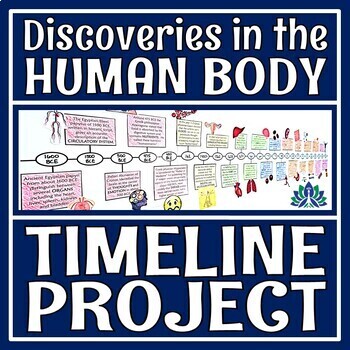Human Body Organ Systems Activity Discoveries of Organ Systems Project TIMELINE
Flying Colors Science
4.8k Followers
Grade Levels
7th - 9th
Subjects
Resource Type
Standards
NGSSMS-LS1-7
NGSSMS-LS1-3
NGSSMS-LS1-1
NGSSMS-LS1-8
Formats Included
- PDF
Pages
20 pages
Flying Colors Science
4.8k Followers
Also included in
- Never search for "something to do tomorrow" ever again! This bundle contains PRINT AND GO lessons, NO PREP activities, LOW PREP labs, and ENGAGING articles to supplement and thoroughly enhance a life science course. Every included resource is easy to implement, standards-based, and high-quality.Price $399.99Original Price $766.48Save $366.49
- 50% OFF! This is a complete ACTIVITY-BASED Organ Systems lesson unit. This bundle includes every resource I use to teach and assess NGSS MS-LS1-3. All of the work has been done for you - from start to finish! An included unit plan tells you what to teach and when, so you don't even have to think aPrice $99.00Original Price $198.00Save $99.00
Description
EASY - JUST PRINT, CUT & ASSEMBLE! Everything you need is included for students to create a Human Body Organ Systems Discoveries Timeline project or bulletin board with 25 entries dating from BCE through 2016. The only supplies necessary are regular copier paper, glue, and colored pencils. Supports NGSS MS-LS1-3.
TWO VERSIONS are provided. Version One requires students to research 25 discoveries (specific prompts provided) and Version Two gives them 25 pre-made informational cards about specific discoveries. Great for differentiation!
Here's the Process for Students:
- Tape or glue together the provided timeline templates (5 - 8.5"x11" sheets).
- Color code the 25 discovery information boxes according to the era of discovery.
- Attach discovery boxes to the timeline.
- Enter the dates.
- Add pictures (provided) to each of the entries.
What's Included:
- 25 Discovery information research boxes for students to complete (Version One)
- 25 Pre-made discovery information boxes (Version Two)
- 25 Human body systems pictures
- Printable timeline template
- Student instructions
- Teacher tips
Teacher Notes:
- This project works well when assigned as a paired project.
- As printed (5 8.5"x11" pages), this timeline is more than 1 meter long, so it also makes a great bulletin board.
- NO COLOR PRINTING IS REQUIRED! The pictures look better in color, but print fine in black and white.
- Please note: This resource is NOT editable.
- Our Human Body Systems ACTIVITIES BUNDLE has lots more fun stuff to do!
Total Pages
20 pages
Answer Key
Included
Teaching Duration
N/A
Report this resource to TPT
Reported resources will be reviewed by our team. Report this resource to let us know if this resource violates TPT’s content guidelines.
Standards
to see state-specific standards (only available in the US).
NGSSMS-LS1-7
Develop a model to describe how food is rearranged through chemical reactions forming new molecules that support growth and/or release energy as this matter moves through an organism. Emphasis is on describing that molecules are broken apart and put back together and that in this process, energy is released. Assessment does not include details of the chemical reactions for photosynthesis or respiration.
NGSSMS-LS1-3
Use argument supported by evidence for how the body is a system of interacting subsystems composed of groups of cells. Emphasis is on the conceptual understanding that cells form tissues and tissues form organs specialized for particular body functions. Examples could include the interaction of subsystems within a system and the normal functioning of those systems. Assessment does not include the mechanism of one body system independent of others. Assessment is limited to the circulatory, excretory, digestive, respiratory, muscular, and nervous systems.
NGSSMS-LS1-1
Conduct an investigation to provide evidence that living things are made of cells; either one cell or many different numbers and types of cells. Emphasis is on developing evidence that living things are made of cells, distinguishing between living and non-living cells, and understanding that living things may be made of one cell or many and varied cells.
NGSSMS-LS1-8
Gather and synthesize information that sensory receptors respond to stimuli by sending messages to the brain for immediate behavior or storage as memories. Assessment does not include mechanisms for the transmission of this information.







